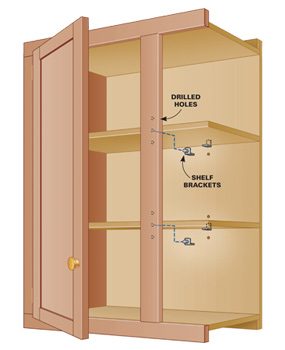
Bathroom cabinet shelves sagging can be a frustrating and unsightly problem. Sagging shelves not only diminish the aesthetic appeal of your bathroom but also pose a safety hazard, potentially causing items to fall and break. This comprehensive guide will delve into the causes of sagging bathroom cabinet shelves and provide practical and effective solutions to get your shelves looking and functioning like new again. We’ll explore various methods, from simple DIY solutions to when professional help is necessary. By the end of this guide, you’ll be well-equipped to tackle this common problem and restore order to your bathroom storage.
Understanding the Causes of Sagging Shelves
Identifying the Root of the Problem
Sagging bathroom cabinet shelves can stem from a variety of factors. One common cause is inadequate support. Poorly installed shelving systems or a lack of sufficient support brackets often lead to shelving instability and subsequent sagging. Another important factor to consider is the weight of the items stored on the shelves. Excessive weight beyond the shelf’s capacity can put significant stress on the supports, resulting in sagging. Additionally, the type of material used for the shelves and cabinets can also play a role. If the material isn’t strong enough or is damaged, it may not be able to withstand the weight, leading to sagging. Finally, consider environmental factors such as moisture or humidity fluctuations which can cause the wooden material of the shelves to swell, leading to the sagging of the shelves. Understanding the reasons behind the sagging will determine the most appropriate solution for your specific situation.
DIY Solutions for Sagging Shelves
Simple Adjustments for Quick Fixes
In many cases, sagging shelves can be addressed with relatively straightforward DIY solutions. One quick fix is to rebalance the weight distribution on the shelves. Remove any items that are contributing to the sagging and rearrange the remaining items to distribute the weight more evenly. You can also use shelf supports or brackets to provide additional support. These supports can be attached to the cabinet walls or to the shelves themselves, bolstering the structural integrity. Look for sturdy materials that can bear the weight of your shelves and cabinets. Make sure the screws are properly tightened to ensure stability. This can often solve minor sagging issues, especially if the weight of items isn’t excessive.
Professional Help and Installation
When to Call in the Experts
If DIY solutions aren’t sufficient, professional help may be required. If the sagging is severe, or if you’re unsure about your skills or tools, hiring a qualified handyman or carpenter can provide a more comprehensive solution. A professional can accurately assess the extent of the damage and determine the most suitable approach. They can also recommend the most suitable materials for your situation and ensure that the installation is done according to best practices and code, ensuring the safety of your bathroom and the durability of the shelves. This is crucial if the sagging is affecting the integrity of the structure or if the cabinets are made from delicate materials.
Maintaining Your Shelves
Preventing Future Sagging
Regular maintenance can help prevent sagging issues in the future. Regularly check your shelves for any signs of sagging or instability. Check for any visible damage or wear and tear. Keep the weight on the shelves balanced and moderate. Avoid overloading shelves with items that exceed their weight capacity. For wooden shelves, keeping them in a well-ventilated environment can help prevent moisture-related issues, as moisture can cause wood to swell and expand, potentially impacting structural integrity. This proactive approach will help to ensure your bathroom shelves retain their optimal functionality and appearance for a long time.
Assessing Shelf Material and Construction
Choosing the Right Materials for Your Needs
The material used in the construction of your shelves will largely dictate their ability to support weight. Wooden shelves, for example, require particular attention to proper support and weight distribution, whereas metal shelves often have greater weight capacity. Choosing the right type of material, considering the expected load, and ensuring appropriate support during installation is essential for preventing future sagging issues. If your current shelves are made of a weak or damaged material, consider upgrading to a more durable option to maintain structural integrity.
In conclusion, sagging bathroom cabinet shelves are a common issue, but with the right solutions and understanding of the root causes, you can easily fix this problem and maintain the aesthetic appeal of your bathroom. Remember to identify the specific cause of sagging, consider the material and weight of the items on the shelves, and ensure proper installation. By implementing these solutions, you can prevent further damage and keep your bathroom shelves functional and attractive for years to come. If the problem persists, consult a professional. Contact a handyman or a carpenter, or even your local hardware store for tips, tools, and recommendations.